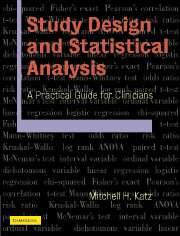Book contents
- Frontmatter
- Contents
- Preface
- 1 Introduction
- 2 Designing a study
- 3 Data management
- 4 Univariate statistics
- 5 Bivariate statistics
- 6 Multivariable statistics
- 7 Sample size calculations
- 8 Studies of diagnostic and prognostic tests (predictive studies)
- 9 Statistics and causality
- 10 Special topics
- 11 Publishing research
- 12 Conclusion
- Index
8 - Studies of diagnostic and prognostic tests (predictive studies)
Published online by Cambridge University Press: 05 August 2012
- Frontmatter
- Contents
- Preface
- 1 Introduction
- 2 Designing a study
- 3 Data management
- 4 Univariate statistics
- 5 Bivariate statistics
- 6 Multivariable statistics
- 7 Sample size calculations
- 8 Studies of diagnostic and prognostic tests (predictive studies)
- 9 Statistics and causality
- 10 Special topics
- 11 Publishing research
- 12 Conclusion
- Index
Summary
How do predictive studies differ from explanatory studies?
The major differences between predictive studies and explanatory studies are shown in Table 8.1.
The goal of predictive studies is to better diagnose illness and more accurately predict prognosis for specific patients. This is different from the goal of explanatory (etiologic) studies: to understand the causes of an illness or condition in a population.
As prediction models are used to make decisions for individual patients, they must predict outcomes with a high degree of certainty. For example, decision rules have been used to predict which patients presenting to an emergency department with possible cardiac ischemia will develop complications and therefore need intensive monitoring. One study found that an adaptation of the Goldman prediction rule correctly identified 89% of the patients who will develop complications. If the clinical rule had only predicted half the patients with complications, it would never be used in clinical practice (and probably never would have been published, at least not in Journal of American Medical Association!). In contrast, all known risk factors for breast cancer account for only about 50% of breast cancer cases. Nonetheless, the results of these explanatory studies are still helpful to us in unraveling the causes of breast cancer.
When the goal is to predict outcome, it does not matter whether the independent variables have a causal relationship to the outcome. If a variable is closely associated with an outcome, such that its presence (or absence) predicts the outcome, that is sufficient. For example, ear lobe creases are a good predictor of coronary artery events (e.g., myocardial infarction, cardiac death) even though they do not cause coronary artery disease.
- Type
- Chapter
- Information
- Study Design and Statistical AnalysisA Practical Guide for Clinicians, pp. 141 - 154Publisher: Cambridge University PressPrint publication year: 2006
- 1
- Cited by



